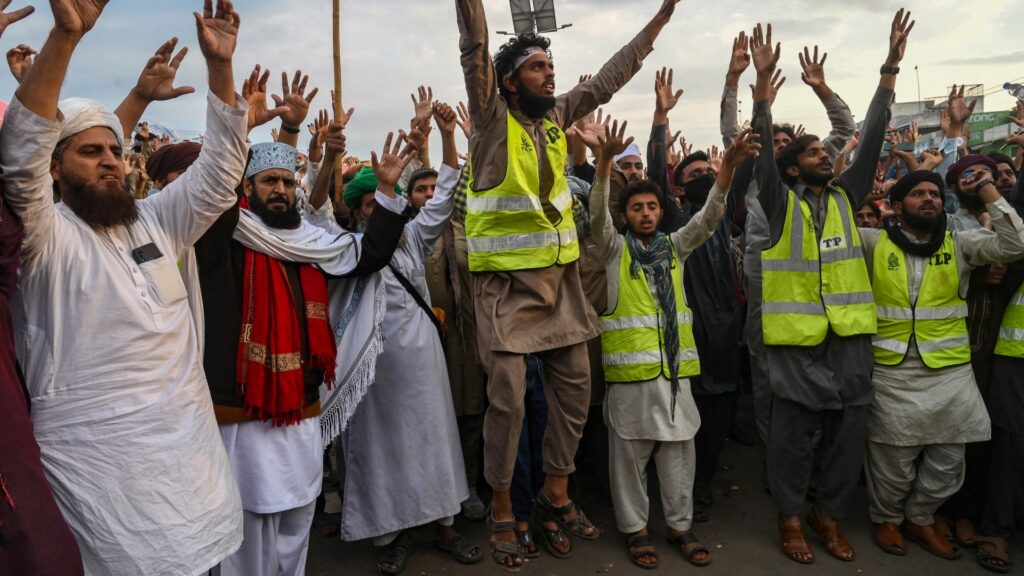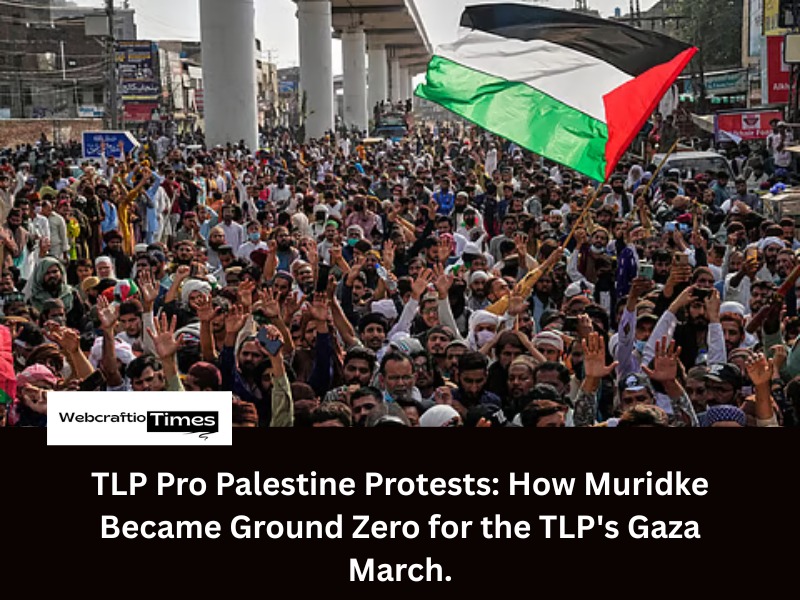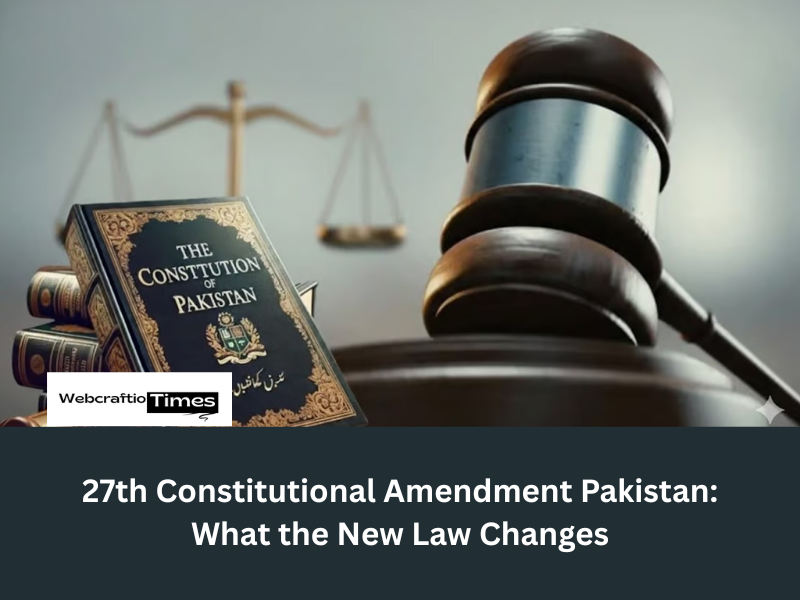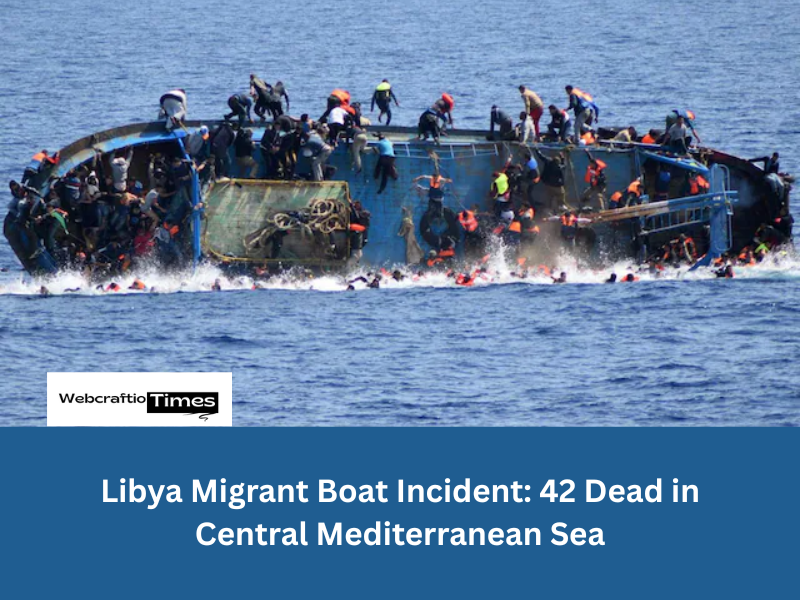I. Introduction: The Muridke Protest
The unstable relationship between the Pakistani government and the Islamist political party, Tehreek-e-Labbaik Pakistan (TLP), reached a new low point in the early hours of October 13, 2025. The “TLP Gaza March in Muridke,” a huge political protest to show support for Palestinians, quickly turned into a violent fight between thousands of protesters and security security forces.
Muridke, a small town on the Grand Trunk (GT) Road close to Lahore, became the centre of political unrest in Pakistan in 2025.
The protesters’ march, led by TLP chief Saad Rizvi TLP, was successfully stopped in Muridke. Following the first violent fights in Lahore. In order to clear up the camp and stop the march from reaching its original destination. Which is gathering outside the US Embassy in Islamabad.
This article gives a detailed analysis of what happened in Muridke. Looking at the reasons behind the march details of the following conflicts. And its important impact on politics across the nation.
II. The origins of TLP Gaza March in Muridke
A powerful combination of global geopolitics and devotion to religion powered the TLP’s most recent rallies. The conflict in Gaza was the main focus of this TLP protest, in contrast with previous ones that were mainly focused on the domestic issues of the blasphemy law or the expulsion of French officials.
Why the TLP Protested: A Stance on Gaza and Israel
The protest’s main goals were to strongly condemn Israeli actions in Gaza and to present a powerful message of support for the Palestinians. A recent ceasefire and hostage agreement in Gaza, which the Pakistani government had carefully supported, especially angered the group’s leadership. This compromise was unacceptable to the TLP.

The march was a clear attempt to pressure the Pakistani government into taking a more aggressive and strong stand against Israel and its allies. Reaching the centre of the capital to organise a rally outside the US Embassy was the second goal. authorities saw this as an urgent and serious national security threat. Despite the extensive deployment of state forces, the TLP protested in Muridke for this long-standing political reason.
TLP Chief Saad Rizvi’s Call to Action
The popular and controversial leader Saad Rizvi TLP personally led the march. Rizvi, who was well-known for his violent speeches and capacity to inspire large gatherings. Presented the march as an Islamic duty, a jihad against enemies of Islam both at home and abroad.
According to official reports. His speeches, which went viral on social media, motivated thousands of supporters to march with sticks, rods, and even guns . The fight was necessary because of the TLP’s constant commitment to carrying on with the TLP long march to Islamabad.
You May Read This : Close to Peace: Understanding the Israel-Hamas Peace Deal
III. The rise of TLP protests from Lahore to Muridke
The journey began in Lahore, the capital of Punjab, immediately after Friday prayers. The first signs of TLP police violence in Pakistan were witnessed here.
Clashes in Lahore: Breaking the Barricades
Upon setting out, the TLP procession met heavy police resistance. Security forces had deployed shipping containers. Set up barricades at key intersections like Azadi Chowk and Yateem Khana Chowk. And they used tear gas to halt the advance.
However, TLP workers, many using government vehicles and cranes they reportedly commandeered, managed to break through several of these barriers. The clashes were brutal, leaving dozens of police officers injured and numerous vehicles damaged or torched. Reports of TLP members seizing police motorbikes and equipment signaled a significant breakdown of law and order in the city.
Muridke as the Tipping Point
The column of protesters eventually reached Muridke. Approximately 35 kilometers north of Lahore. Where the district administration and a massive contingent of law enforcement agencies had established an impenetrable cordon. Large trenches were dug across the GT Road. Additional police and paramilitary units (Pakistan Rangers) were dispatched from multiple districts across TLP protest Punjab to create a formidable defensive line. Muridke thus became the containment zone. The final point where the government was determined to stop the TLP long march to Islamabad. When two attempts by the protesters to push past the blockades on Sunday were forcefully thwarted. The situation solidified into a tense, volatile standoff.
IV. The Pre-Dawn Crackdown: Violence Erupts (TLP police violence Pakistan)
With negotiations stalled. Adviser to the Prime Minister Rana Sanaullah later confirmed that there were no formal talks. Only contact the government decided to execute a rapid, decisive operation.
Details of the Operation
The crackdown began at approximately 3:00 am on Monday. A force of nearly 1,500 police and Rangers personnel, equipped with anti-riot gear, armoured personnel carriers, and water cannons, moved in to clear the TLP protest camp. The operation, which lasted for several hours, was characterized by extreme violence.
According to officials, some 1,500 police personnel in full anti-riot gear, supported by four armoured personnel carriers and water cannons, surrounded the protest camp along the GT Road. Resource: DAWN
According to police accounts, the law enforcement personnel were met with fierce resistance. Protesters allegedly used stones, batons with nails, and “petrol bombs,” and later opened fire on the advancing police lines. Officials stated that their personnel initiated a “limited action in their defence” to disperse the armed mob, which they accused of committing acts of open treason and terrorism. Images and videos from the scene circulating online later showed multiple burnt vehicles and thick smoke, testament to the intensity of the confrontation.
Casualties and Conflicting Claims
The operation resulted in fatalities and a significant number of injuries on both sides.
- Official Police Figures: Punjab Police confirmed the death of at least one Station House Officer (SHO) from the Factory Area Police Station in Sheikhupura, who was reportedly shot. They also reported three TLP workers and one passerby killed. Along with over 48 law enforcement personnel injured, 17 of whom sustained bullet wounds.
- TLP Claims: The TLP, however, offered dramatically different figures, claiming that multiple members were killed some reports citing figures as high as 11 or more and hundreds injured due to alleged indiscriminate firing and use of “lethal weapons” by the police and Rangers.
The discrepancy in casualty figures made it challenging to ascertain the full human cost of the TLP crackdown details and casualties, leading to calls for an independent judicial inquiry into the use of force.
V. The Aftermath and Political Fallout (Pakistan political unrest 2025)
By Monday evening, the authorities had cleared the camp, and the protesters had largely dispersed. Roads in and around Muridke were reopened. Connectivity which had been severely curtailed by the suspension of mobile data services in Islamabad and Rawalpindi was slowly restored.
Arrests and Legal Action Against TLP Activists
In the immediate aftermath, law enforcement agencies launched a sweeping operation to detain TLP workers. Hundreds of activists and office-bearers were arrested. Both at the site of the clashes and in overnight raids across the Punjab province. Anti-terrorism courts remanded over 100 TLP activists to police custody on charges of vandalism, assault, terrorism, and attacking public property. The government signaled its resolve to use the full force of the law against any group attempting to “blackmail” the state through violence.
Want More Latest News & Updates ? Click Here
Government Rationale and Criticism
Minister of State for Interior, Talal Chaudhry, accused the TLP of exploiting the emotionally charged issue of Gaza for political gain. Stating that while the right to peaceful protest is constitutional, there is no space for violence or mob coercion.
However, the government’s heavy-handed approach drew sharp criticism from the opposition, notably the Pakistan Tehreek-e-Insaf (PTI). The PTI condemned the alleged killings of TLP marchers, drawing parallels between the Muridke tragedy and past instances of state violence, and demanded the immediate resignation of the Punjab Chief Minister. The opposition argued that a failure to engage in meaningful dialogue was directly responsible for the escalation of violence.
Political Reactions: Calls for Accountability
The event underscored the deep volatility in Pakistan political unrest 2025. The clash demonstrated the TLP’s persistent ability to paralyze major parts of the country and challenge state authority. While simultaneously highlighting the government’s determination to prevent major metropolitan areas from falling under siege. The demand for an independent probe into the violence. Particularly the conflicting reports on the fate of Saad Rizvi TLP (who was rumored to have been injured or shot but later confirmed by police not to be in custody), remains a major point of contention.
VI. Historical Context: TLP’s History of Disruption
The events in Muridke are not isolated; they are part of a recurring cycle of confrontation that defines the TLP’s political methodology.
Mobilizing Power and Core Ideology
The TLP, which rose to prominence in 2015, distinguishes itself from mainstream political parties through its single-minded focus on the finality of the Prophethood and the defense of Pakistan’s blasphemy laws. This ideology grants them immense mobilizing power among a segment of the public. They have repeatedly demonstrated their capability to bring major cities to a halt, turning their protests into effective tools for extracting concessions from successive governments.
Precedents of Violent Protests
The TLP police violence Pakistan witnessed in Muridke echoes similar events from previous years. Including the widespread and violent demonstrations in 2021 that also led to the martyrdom of police officers and the temporary proscribing of the party. The consistent use of force by both the protesters and the state highlights an enduring failure to find a non-violent mechanism to manage the party’s frequent challenges to authority.
VII. Conclusion: A Recurring Cycle of State vs. Street
The violent crackdown in Muridke successfully halted the TLP long march to Islamabad and dispersed the protesters, leading to a temporary return to normalcy. However, the events have come at a heavy cost. The tragic loss of life, the dozens of injuries, and the mass arrests have only served to deepen the rift between the state and the TLP’s support base.
The incident at the Muridke crossroads will undoubtedly serve as a potent rallying cry for the TLP in the future. Feeding the narrative of a state crackdown on a religious movement. Until a sustainable strategy is found one that balances the constitutional right to protest with the imperative of maintaining public order Pakistan is likely to face a repeat of these disruptive and violent cycles of Pakistan political unrest 2025. The political heat generated by the TLP protests Muridke will continue to simmer, a stark reminder of the country’s precarious internal security landscape.
FAQs on the TLP Protests in Muridke
1. What was the main reason the TLP marched from Lahore towards Islamabad?
The main reason was to stage a “Gaza Solidarity March” to express strong support for Palestinians and condemn Israel’s actions in Gaza. The TLP specifically aimed to hold a demonstration outside the US Embassy in Islamabad and opposed the recently brokered Gaza ceasefire deal.
2. Why did Muridke become a major flashpoint during the protest?
Muridke was where the TLP march was effectively contained. Authorities set up a major blockade, including trenches and a massive deployment of police and paramilitary Rangers, to prevent the protesters from advancing further on the Grand Trunk (GT) Road toward Islamabad.
3. Did the clashes in Muridke result in any casualties?
Yes, the clashes resulted in fatalities and numerous injuries on both sides. The Punjab Police confirmed the death of at least one Station House Officer (SHO) and several TLP workers and a passerby. Dozens of police personnel and protesters also sustained injuries.
4. Who led the TLP’s “Gaza March”?
The protest march was led by the chief of the Tehreek-e-Labbaik Pakistan (TLP), Saad Rizvi.
5. What was the government’s official stance regarding the violence and the subsequent crackdown?
The government maintained that while peaceful protest is a constitutional right, there is no tolerance for violence, coercion, or any attempt to “blackmail” the state. They accused the TLP of exploiting the Gaza issue for political gain and asserted that the police operation was necessary to maintain law and order and protect public property.



